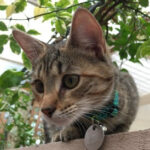My cat, Mr. Bundles, was a character. From the moment I brought him home, food was his primary focus. He wasn’t just eating; he was devouring his meals with such speed and intensity that it sounded like he was trying to excavate the bottom of his food bowl. Dry food wasn’t safe either. Left to his own devices, Mr. Bundles would stage elaborate heists to break into the pantry, driven by a singular, food-motivated mission during my workdays. Initially, a 35-pound tub of cat litter was my pantry door barricade, but his determination was unmatched. Eventually, it took a double-stacked, 70-pound litter fortress to finally deter his pantry raids.
While blocking pantry access solved the overeating issue, it didn’t address the underlying frustration that gnawed at him between meals. Back then, I was still on a twice-a-day feeding schedule. Once breakfast or dinner vanished, the hours stretching until the next meal likely felt like an eternity in Mr. Bundles’ world. As feeding time approached, his agitation grew. He’d become increasingly vocal and even redirect his food-related stress onto his housemates, Navin and Puff, who were simply trying to enjoy their meals at a reasonable pace.
It was during this time that I discovered Cat Food Puzzles, a relatively new concept. These stationary or mobile devices are designed to hide food, tapping into a cat’s natural hunting instincts and providing essential mental stimulation. Using a cat food puzzle throughout the day also mimics a cat’s natural eating pattern – multiple small meals rather than two large ones. Plus, Mr. Bundles had gained a bit of weight, so incorporating a puzzle feeder would encourage him to be more active.
The first cat food puzzle I introduced was actually designed for dogs: the mini Buster Cube. This royal blue cube had a top opening for filling it with kibble or treats. The inside was cleverly designed with compartments, like Swiss cheese, to trap the food and offer adjustable difficulty levels. While canned food remained Mr. Bundles’ primary diet, I started offering him a daily Buster Cube snack of dry kibble. His interest was immediate. The moment he saw me filling this intriguing new toy, a sniff turned into pawing, and finally, a kibble tumbled out. Success! Puff quickly joined the fun, mastering a spin-and-flick technique like a bowling pro.
However, this was before I understood the importance of separate feeding areas for cats. Mr. Bundles soon discovered a more efficient strategy: letting Puff do all the work. He’d lounge back, observing Puff intently. The instant a kibble emerged, Mr. Bundles would swoop in, gobbling it up before Puff could react. Initially, I found it amusing, but as my understanding of cat behavior deepened, I realized it wasn’t so funny for Puff. Competition for resources, like feeding stations, increases stress and can trigger conflict between cats.
The solution was simple: a second pink Buster Cube for Puff (blue for B, pink for Puff) and separate feeding times behind closed doors for Mr. Bundles. This made a world of difference. While we explored other types of interactive feeders and cat treat puzzles, their Buster Cubes remained a staple, especially on long workdays. The pantry break-in attempts decreased, and all my cats seemed much more content and relaxed. Introducing the cat food puzzle was a game-changer for Mr. Bundles’ well-being.
When Mr. Bundles passed away in December 2022, Puff inherited his cube and the extensive puzzle feeder collection. By then, Puff was a Buster Cube master. To continue providing enrichment, I transitioned to foraging. Now, two to three times daily, I hide portions of Puff’s kibble around the house for him to discover. Initially, I placed them in easy spots, like his beds, ensuring quick finds. As he started actively using his nose to hunt, I began hiding kibble at varying heights, under blankets, and in new locations to encourage exploration. I even incorporated a Snuffle Mat, draping it over the couch back and embedding kibble within. Witnessing a cat tilt their nose, flare their nostrils, and sniff sniff sniff is truly adorable. Sniffing releases endorphins in dogs, and I believe it has the same positive effect on cats. Puff, prone to anxiety and weight gain, benefited immensely. Foraging became a low-cost way to support his emotional health and increase his physical activity. Cat food puzzles, in all their forms, have been invaluable tools in enriching my cats’ lives.

